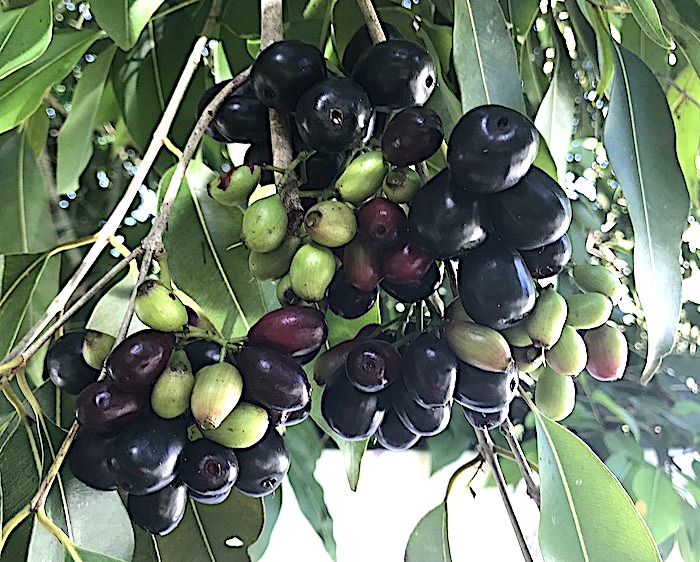
The Java Plum, or Jambul Fruit, is very high in tannins. Photo by Green Deane
What can be said about the Jambul Tree? First, if you don’t like the name you can call it the Java Plum. The Indians prefer Jamun. The tree also demonstrates quite a few principles. One is that the toxin is often on the outside. Why? Because that is where insects, birds and other animals attack first. This is why green potatoes can make you sick if you eat the skins. In the case of the Jambul Tree the skin of the sweet fruit is loaded with tannin, about 10 times more than a red grape. So they are edible but there is a bitter astringency. Sprinkling with salt or soaking in salted water can reduce that. More on that in a moment.
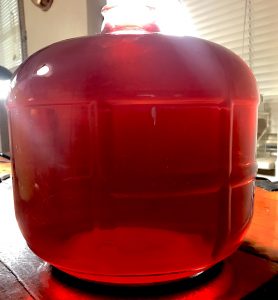
Two and a half gallons of Jambul Wine before racking. Photo by Green Deane
Another principle being demonstrated this year is that Mother Nature rules. Last year the edible terrestrial mushroom season was off by six weeks because seasonal rains were either late or light. Last year the Jambul Trees fruited in early August. This year the rains have been iffy as is the fruiting. Foraging includes, among many skills, watching the weather. The major impediment to the tree — though it is a commercial fruit — is the tannins. Salt does mitigate that some when eating them fresh and is reported to lower blood glucose levels. Making wine out of the fruit is a challenge because of the tannin. Often when you make wine you have to add tannin. In this case one has to use strategies to reduce the tannin. This ranges from yeast selection to fining agents that grab onto the large tannin molecules and help them sink to the bottom so they can be left there. You can read about the Jambul Tree here.
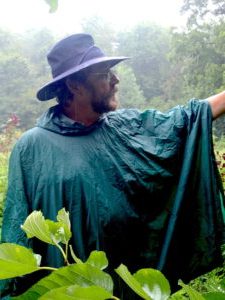
Classes are held rain or shine.
Foraging Classes: You will note that besides local classes I will be holding four foraging classes in South Carolina in mid-July.
Saturday, June 12th, Dreher Park, 1200 Southern Blvd., West Palm Beach, 33405. 9 a.m. to noon. Meet just north of the science center.
Sunday, June 13th, Bayshore Live Oak Park, Bayshore Drive. Port Charlotte. 9 a.m to noon, meet at the parking lot at Ganyard and Bayshore.
Saturday, June 19th, Red Bug Slough Preserve, 5200 Beneva Road, Sarasota, FL, 34233. 9 a.m. to noon.
Sunday, June 20th, Colby-Alderman Park: 1099 Massachusetts Street, Cassadaga. Fla. 32706. 9 a.m. to noon, meet at the bathrooms.
Saturday, June 26th, Eagle Park Lake, 1800 Keene Road, Largo, FL 33771. 9 a.m. to noon, meet at the pavilion near the dog park.
Sunday, June 27th, Blanchard Park, 10501 Jay Blanchard Trail, Orlando, FL 32817. 9 a.m. to noon. Meet beside the tennis courts.
Saturday July 17th, Classes at 9 a.m. and 1 p.m at Putney Farm, 1624 Taylor Rd, Honea Path, SC 29654.
Sunday July 18th, Classes at 9 a.m. and 1 p.m at Putney Farm, 1624 Taylor Rd, Honea Path, SC 29654.
For more information, to prepay or sign up for a class go here.
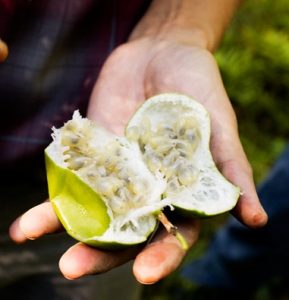
Maypop fruit is sweet and tart.
Maypops are not named for the month of May. Nor are they called “pops” because of the sound they make if you stomp on them. “Maypop” is a “cognate” for a Native American name for the edible plant. In Gainesville recently a lot of them were getting ready to ripen. The odd thing was we could not find any ripe ones. There were plenty of plump green fruit many with sweet and tart seeds and pulp inside. None, however, had ripened to yellow. Another possibility is the denizens of the forest are gobbling up every ripe one they can find. It is after all their grocery store. Taking our lead from them now is the time to be looking for Maypops and learn about their many uses. You can read about them here.
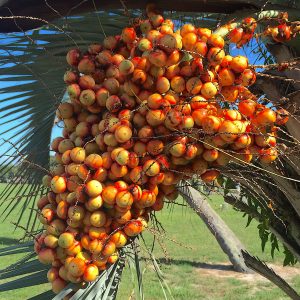
Pindo Palm can fruit almost anytime. Photo by Green Deane
Also seen is a fruit I have to restrict myself or I will just eat too many I like the flavor so much. Pindo Palms, which can grow as far north as Washington DC, have a long fruiting season. When it starts is always a bit iffy. Around Memorial Day is as good as any date. But I had not personally seen any ripe fruit this season until today. Of all the palm fruit I have ever tried Pindo is way above the rest. I am surprised it is not a commercial fruit. In fact in my capacity as a consultant for Bacardi I recommended they explore the fruit for distilling purposes. It already has a long history of being used for wine (I have three gallons at the moment.) As mentioned in previous newsletters I do not have a sweet tooth but Pindo Palm fruit is one of those delicious exceptions that I have to restrict myself with. You can read about Pindo Palms here.
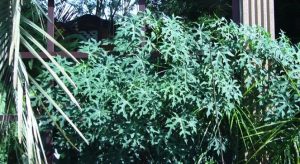
Leaves of the Chaya can sting whether wild or cultivated. Photo by Green Deane
This was covered earlier this year but I thought it worth another mention because the species is in heavy blossom. Chaya, a tropical American “food tree.” It is closely related to our local Spurge Nettle. As one might expect Chaya grows in the wild in tropical climates and like the Spurge Nettle stings. The sting to me is annoying but manageable. It goes away in about a hour with me so by the time I think of it a second or third time the stinging is over. The leaves are mashed and or cooked. They have a little bit of cyanide which is why cooking is recommended. Surprisingly the cooking water is safe to drink and is high in vitamin C. There are local reports that I have not followed up on that our Spurge Nettle leaves can be cooked and eaten. It’s one of those things I might try when I have a few days to be ill. You can read about Chaya here.

Green Deane videos are now available on a USB.
150-video USB would be a good spring present and is now $99. My nine-DVD set of 135 videos has been phased out. The USB videos are the same videos I have on You Tube. Some people like to have their own copy. The USB videos have to be copied to your computer to play. If you want to order the USB go to the DVD/USB order button on the top right of this page. That will take you to an order form. I’d like to thank all of you who ordered the DVD set over the years which required me to burn over 5,000 DVDs individually.

Green Deane Forum
Want to identify a plant? Perhaps you’re looking for a foraging reference? You might have a UFO, an Unidentified Flowering Object, you want identified. On the Green Deane Forum we — including Green Deane and others from around the world — chat about foraging all year. And it’s not just about warm-weather plants or just North American flora. Many nations share common weeds so there’s a lot to talk. There’s also more than weeds. The reference section has information for foraging around the world. There are also articles on food preservation, and forgotten skills from making bows to fermenting food. 
Your donations to upgrade the EatTheWeeds website and fund a book were appreciated. A book manuscript has been turned it. It had 425 articles, 1326 plants and a third of a million words. What it will be when the publisher is done with it next year is unknown. It will be published in the spring of 2023. Writing it took a significant chunk of time out of my life from which I have still not recovered. (Many things got put off.) The next phase is to update all the content on the website between now and publication date. Also note as it states above the 135-video DVD set has been phased out for 150-video USB. Times and formats change. Which reminds me I need to revisit many plants and make some new videos.
This is weekly newsletter #460. If you want to subscribe to this free newsletter you can find the sign-up form in the menu at the top of the page.
To donate to the Green Deane Newsletter click here.

